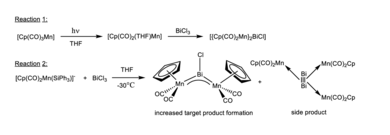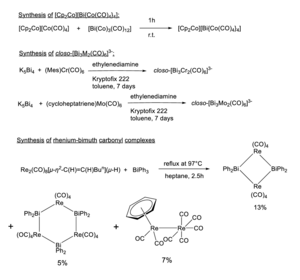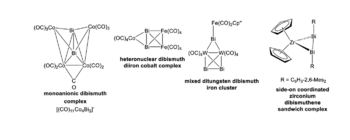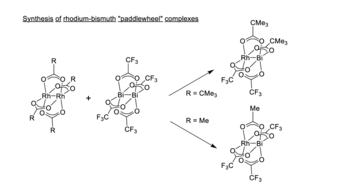Chemistry:Bismuth organometallic chemistry
The stabilization of bismuth's +3 oxidation state due to the inert pair effect yields a plethora of organometallic bismuth-transition metal compounds and clusters with interesting electronics and 3D structures.[1]
Catalysts
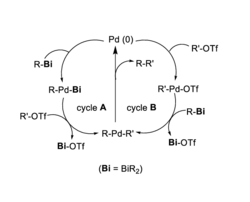
Due to the inert pair effect of the heavy, organometallic compounds of Bi (III) show Lewis acid properties given the lower ability of the 6s electron pair to mix with molecular orbitals and form σ-bonds.[2] The search for non-toxic equivalents of boronic acids in advancing the Suzuki-Miyaura carbon-carbon coupling reactions and expand the scope of carbon-nitrogen and carbon-oxygen coupling ones turned chemists' attention to organometallic bismuch chemistry.[2] Two catalytic mechanisms were proposed in the C-C bond formation catalyzed by bismuth organometallic compounds. The major difference arises from the rate of the oxidative addition to Pd(0) into a C-Bi bond or C-O one, yielding cycles A and B, respectively (see image).
Compounds with a metal-Bi σ-bond

Among the first representatives of the organometallic bismuth chemistry are a series of iron cyclopentadienyl compounds synthesized by Cullen et al. Characteristic to these is a σ Fe-Bi bond, the iron center bound to 1 cyclopentadienyl and to carbon monoxide ligands only having 17 electron in its coordination sphere in the absence of the Bi bond.[3][4]
Adding to this, Huttner et al. described the synthesis of mixed Mn-Bi compounds. Most of the synthetic routes use bismuth trichloride as the bismuth metal source.[5] The first proposed route relied on manganese cyclopentadienyl tricarbonyl as the starting material. A better yielding route employed [Cp(CO)2Mn(SiPh3)] anionic species as the manganese metal source.[2] The synthesized [{Cp(CO)2Mn}2BiCl] adduct dimerizes in the solid-state.
Bismuth compounds derived from transition metal carbonyl complexes
Compounds derived from various transition metal carbonyl complexes are organometallic representatives with somewhat unusual cyclic structure and electronics. Such a representative is given in the form of the paramagnetic, ten-electron, tetrahedral [Cp2Co][Bi{Co(CO)4}4] complex.[6]
Additionally, clusters like closo-[Bi3Cr2(CO)6]3- and [Bi3Mo2(CO)6]3- have been reported to stabilize the ozone-like structure of [Bi3]3-.[7] The [Bi3]3- species, isostructural and isoelectronic with ozone, can be analyzed independently as a moiety bound to the metal carbonyl complexes. The reported Bi-Bi distance falls in between the single and double bond region and is elongated compared to Bi=Bi bond in the [Bi4]2- cluster, the later displaying a bond order of 1.25.[7] This experimental observation is being rationalized by some amount of π-donation to the metal carbonyl center and simultaneously π* back-bonding to the bismuth cluster from the metallocene complex.[7]
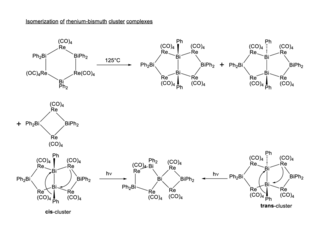
In 2009, Pearl et al. described the synthesis and isomerization of heterometallic complexes containing bismuth and rhenium. The precursors used in synthesis were an alkene-coordinated carbonyl rhenium complex and BiPh3.[8] The reaction yields two types of heteronuclear bismuth-rhenium complexes and a homodinuclear rhenium one as a side product. Upon heating, the hexametallic tribismuth-trirhenium heteronuclear complex undergoes isomerization to cis- and trans-clusters containing the bicyclo [3.3.0] core (see scheme below). Under subsequent irradiation both stereoisomers convert to a common spiro [4.3] cluster compound.[8]
Dibismuth transition metal-clusters
Adding to the transition metal-bismuth carbonyl clusters, the dibismuth clusters with transition metals have also been explored by synthetic chemists. The core of such compounds is represented in the form of dibismuthene or dibismithyne unit, in which the Bi atoms contain the inert 6s lone pair and through π-bond-donation are able to coordinate to carbonyl moieties of transition metals .[2]
The common synthetic precursor is the trimethylsilylmethyl-cyclobismuthane. Upon reaction with tungsten pentacarbonyl, the resulting side-on adduct preserved the dibismuthene unit, while reaction with diiron noncarbonyl yields the a tetracylic heteronuclear iron-bismuth carbonyl compound (see scheme to the right).[9][10]
The complexity of the dibismuthene complexes ranges from incorporation of cobalt ions to generate a prismatic cobalto carbonyl dicapped structure in the [(CO)11Co4Bi2]- structure to iron incorporation to yield diiron dibismuth tetracyclic moiety side-on capped with cobaltocarbonyl unit.[11][2] A similar structure was synthesized with tungsten replacing the iron units and this time capped with a bismuth-iron carbonyl-Cp'' unit.[2] Finally, another example comes in the form of a side-on coordinated zirconium dicyclopentadienyl unit to the dibismuth mesitylene moiety (see figure).[12]
Bismuth-containing clusters
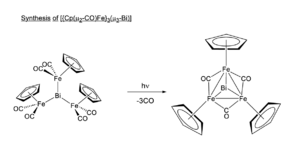
Multiple bismuth-containing clusters were reported, some of them synthesized through carbon monoxide ligand loss from the previously reported bismuth complexes.[2] Strained cluster complexes with monodentate as well as bridging carbon monoxide units have also been isolated, such as [{Cp(μ2-CO)Fe}3(μ3-Bi)] and [(µ3-Bi)Co3(CO)6(µ-CO)3].[13]
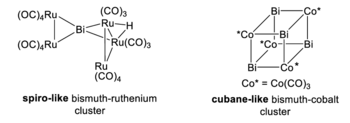
Spiro-like clusters such as [{Ru2(CO)8}(µ4-Bi){(µ-H)Ru3(CO)10} and cubane-like ones as [Bi4Co*4] are representatives as well.[2] The former displays a tetracoordinate bismuth metallic center along with a dicoordinated hydride ligand. The structure of the latter is cubic with the edges alternating bismuth and cobalt metallic centers.
"Paddlewheel" complexes
Inspired from the dirhodium tetraacetate bimetallic salt, synthetic chemists decided to explore the synthesis of paddlewheel mixed heteronuclear bismuth-rhodium salts. The synthesis involves treatment of the [Rh2(O2CR)4] salt with the dibusmuth tetrafluoroacetate [Bi2(O2CCF3)4] equivalent.[14][15] Depending on the nature and sterics of the R ligand, the resulting mixed salt has either two tBu R-substituents resulting in the cis mixed salt or a single Me R-substituent provenient from the dirhodium precursor (see scheme to the right). The mixed salts display increased air and moisture compared to the parental dimetallic salts and show Lewis acidity at the rhodium center.[2]
See also
- Organobismuth chemistry
- Bismuth compounds
References
- ↑ Braunschweig, Holger; Cogswell, Paul; Schwab, Katrin (January 2011). "Synthesis, structure and reactivity of complexes containing a transition metal–bismuth bond". Coordination Chemistry Reviews 255 (1–2): 101–117. doi:10.1016/j.ccr.2010.07.002.
- ↑ Jump up to: 2.00 2.01 2.02 2.03 2.04 2.05 2.06 2.07 2.08 2.09 2.10 2.11 2.12 2.13 2.14 2.15 Braunschweig, Holger; Cogswell, Paul; Schwab, Katrin (2011-01-01). "Synthesis, structure and reactivity of complexes containing a transition metal–bismuth bond". Coordination Chemistry Reviews 255 (1): 101–117. doi:10.1016/j.ccr.2010.07.002. ISSN 0010-8545. https://www.sciencedirect.com/science/article/pii/S0010854510001712.
- ↑ Jump up to: 3.0 3.1 Cullen, W. R.; Patmore, D. J.; Sams, J. R. (1973). "Synthesis of transition metal derivatives of arsenic, antimony, and bismuth with M-E sigma bonds" (in en). Inorganic Chemistry 12 (4): 867–872. doi:10.1021/ic50122a032. ISSN 0020-1669. https://pubs.acs.org/doi/abs/10.1021/ic50122a032.
- ↑ Jump up to: 4.0 4.1 Cullen, W. R.; Patmore, D. J.; Sams, J. R.; Newlands, M. J.; Thompson, L. K. (1971-01-01). "Cyclopentadienyldicarbonyliron derivatives of arsenic, antimony and bismuth with M–Fe σ-bonds (MAs, Sb, Bi)" (in en). Journal of the Chemical Society D: Chemical Communications (16): 952–953. doi:10.1039/C29710000952. ISSN 0577-6171. https://pubs.rsc.org/en/content/articlelanding/1971/c2/c29710000952.
- ↑ Jump up to: 5.0 5.1 Von Seyerl, Joachim; Huttner, Gottfried (1980-08-19). "Wismut(I)-chlorid, BiCl, als komplexligand: darstellung und struktur von [C5H5(CO)2Mn)2BiCl2"]. Journal of Organometallic Chemistry 195 (2): 207–212. doi:10.1016/S0022-328X(00)90005-6. ISSN 0022-328X. https://www.sciencedirect.com/science/article/pii/S0022328X00900056.
- ↑ Jump up to: 6.0 6.1 Leigh, J. Scott; Whitmire, Kenton H. (1988). "[Cp2Co[Bi{Co(CO)4}4 ]: A Paramagnetic, Ten‐Electron, Tetrahedral Complex of Bismuth"] (in en). Angewandte Chemie International Edition in English 27 (3): 396–398. doi:10.1002/anie.198803961. ISSN 0570-0833. https://onlinelibrary.wiley.com/doi/10.1002/anie.198803961.
- ↑ Jump up to: 7.0 7.1 7.2 7.3 Xu, Li; Ugrinov, Angel; Sevov, Slavi C. (2001-05-01). "Stabilization of Ozone-like [Bi33- in the Heteroatomic closo -Clusters [Bi3Cr2(CO)6]3- and [Bi3Mo2(CO)6 ]3-"] (in en). Journal of the American Chemical Society 123 (17): 4091–4092. doi:10.1021/ja0038732. ISSN 0002-7863. https://pubs.acs.org/doi/10.1021/ja0038732.
- ↑ Jump up to: 8.0 8.1 8.2 8.3 Adams, Richard D.; Pearl, William C. (2009-10-05). "Rhenium−Bismuth Carbonyl Cluster Compounds" (in en). Inorganic Chemistry 48 (19): 9519–9525. doi:10.1021/ic901176x. ISSN 0020-1669. PMID 19711899. https://pubs.acs.org/doi/10.1021/ic901176x.
- ↑ Jump up to: 9.0 9.1 Balázs, Lucia; Breunig, Hans Joachim; Lork, Enno (2002-07-03). "Synthesis of the Dibismuthene Complex [{μ-η2-(cis-Me3SiCH2Bi)2}{W(CO)5}2 from a Cyclobismuthane and [W(CO)5(thf)]"] (in en). Angewandte Chemie International Edition 41 (13): 2309–2312. doi:10.1002/1521-3773(20020703)41:13<2309::AID-ANIE2309>3.0.CO;2-M. ISSN 1433-7851. https://onlinelibrary.wiley.com/doi/10.1002/1521-3773(20020703)41:133.0.CO;2-M.
- ↑ Jump up to: 10.0 10.1 Breunig, Hans Joachim (2005). "Organometallic Compounds with Homonuclear Bonds between Bismuth Atoms, 70 Years after Paneth' Report on the Violet Dimethyl Bismuth Compound" (in en). Zeitschrift für anorganische und allgemeine Chemie 631 (4): 621–631. doi:10.1002/zaac.200400476. ISSN 0044-2313. https://onlinelibrary.wiley.com/doi/10.1002/zaac.200400476.
- ↑ Jump up to: 11.0 11.1 Martinengo, Secondo; Ciani, Gianfranco (1987-01-01). "Bismuth–cobalt heteronuclear carbonyl cluster compounds. Synthesis and X-ray characterization of the neutral [BiCo3(CO)9 and of the paramagnetic anion [Bi2Co4(CO)11]–"] (in en). Journal of the Chemical Society, Chemical Communications (20): 1589–1591. doi:10.1039/C39870001589. ISSN 0022-4936. https://pubs.rsc.org/en/content/articlelanding/1987/c3/c39870001589.
- ↑ Jump up to: 12.0 12.1 Wang, Yuzhong; Quillian, Brandon; Yang, Xiao-Juan; Wei, Pingrong; Chen, Zhongfang; Wannere, Chaitanya S.; Schleyer, Paul v. R.; Robinson, Gregory H. (2005). "A Metallocene-Complexed Dibismuthene: Cp2Zr(BiR)2 (Cp = C5H5; R = C6H3-2,6-Mes2)". J. Am. Chem. Soc. 127 (21): 7672–7673. doi:10.1021/ja051704h. PMID 15913345. https://doi.org/10.1021/ja051704h.
- ↑ Whitmire, Kenton H.; Leigh, J. Scott; Gross, Michal E. (1987-01-01). "Isolation and characterization of the 'strained' cluster complex, (µ3-Bi)Co3(CO)6(µ-CO)3; the application of thermogravimetric analysis to rational cluster reactions" (in en). Journal of the Chemical Society, Chemical Communications (12): 926–927. doi:10.1039/C39870000926. ISSN 0022-4936. https://pubs.rsc.org/en/content/articlelanding/1987/c3/c39870000926.
- ↑ Jump up to: 14.0 14.1 Dikarev, Evgeny V.; Li, Bo; Zhang, Haitao (2006). "Tuning the Properties at Heterobimetallic Core: Mixed-Ligand Bismuth−Rhodium Paddlewheel Carboxylates". J. Am. Chem. Soc. 128 (9): 2814–2815. doi:10.1021/ja058294h. PMID 16506756. https://doi.org/10.1021/ja058294h.
- ↑ Jump up to: 15.0 15.1 Dikarev, Evgeny V.; Li, Bo; Rogachev, Andrey Yu.; Zhang, Haitao; Petrukhina, Marina A. (2008-08-01). "Metal-Site-Controlled Arene Coordination in a Heterobimetallic Bi−Rh Complex with Pyrene" (in en). Organometallics 27 (15): 3728–3735. doi:10.1021/om8001763. ISSN 0276-7333. https://pubs.acs.org/doi/10.1021/om8001763.
 |
